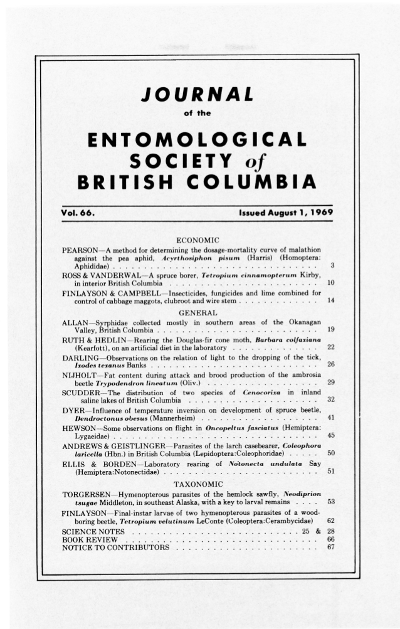Some observations on flight in <i>Oncopeltus fasciatus</i> (Dallas) (Hemiptera: Lygaeidae)
Keywords:
<i>Oncopeltus fasciatus</i>, Hemiptera, LygaeidaeAbstract
<i>Oncopeltus fasciatus</i> (Dallas) is a typical Hemipteran with forewings modified to form hemielytra and membraneous hind-wings. During flight, these two pairs of wings are linked together by a wing coupling apparatus. Observations were made on normal insects and insects with either fore- or hind-wings removed. The experiments demonstrated that the mesothorax with the fore-wings is the most important segment of the pterothorax in this insect. It was shown that the fore-wings provide the main propulsive force for flight and also provide much of the lift: the hind-wings provide extra-surface for lift, but this is effective only if the wings are coupled together. As in the Lepidoptera and Hymenoptera, where the two pairs of wings are also linked together by a wing coupling apparatus, it appears that the musculature of the mesothorax may be the "driving force" for both pairs of wings.References
Chadwick, L.E. 1953. The motion of wings. In: Roeder, K.D. (ed) Insect Physiology, Wiley, New York: 577-615.
Dingle, H. 1965. The relationship between age and flight activity in the milkweed bug. J. Exp. Biol. 42:269-283.
Pringle, J.W.S. 1957. Insect Flight. Cambridge University Press, London.
Pringle, J.W.S. 1968. Comparative physiology of the flight motor. Adv. Ins. Physiol. 5:163-227.
Scudder, G.G.E. 1967. Notonecta borealis (Bueno & Hussey): a flightless species? Ent. Mon. Mag. 102:258-259.
Weber, H. 1930. Biologie der Hemipteren, Julius Springer, Berlin.
Downloads
Published
Issue
Section
License
Authors who publish with the Journal of the Entomological Society of British Columbia agree to the following terms:
-Authors retain copyright and grant the journal right of first publication with the work simultaneously licensed under a Creative Commons Attribution License that allows others to share the work with an acknowledgement of the work's authorship and initial publication in this journal.
-Authors are able to enter into separate, additional contractual arrangements for the non-exclusive distribution of the journal's published version of the work (e.g., post it to an institutional repository or publish it in a book), with an acknowledgement of its initial publication in this journal.
-Authors are permitted and encouraged to post their work online (e.g., in institutional repositories or on their website) prior to and during the submission process, as it can lead to productive exchanges, as well as earlier and greater citation of published work (See The Effect of Open Access).


